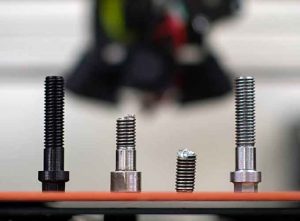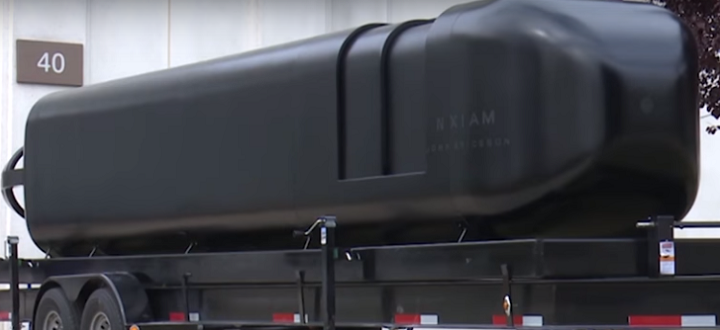3D Printing Keeps Navy Ships Up and Running for Minimal Cost
 3D printing has become a bigger part of life in the United States Navy, and indeed in all branches of the military, as servicepeople come up with ingenious ways to use the technology to save time and money and overall make life easier. Last month, the USS Chung-Hoon Arleigh Burke-class guided-missile destroyer ran into some trouble when a bolt from a hangar bay roller assembly became stressed to the point of breaking. The damaged bolt meant that the door could not open and close properly. Instead of being able to replace one simple part, the Chung-Hoon would need to order an entirely new roller assembly, which the ship didn’t have time to wait for.
3D printing has become a bigger part of life in the United States Navy, and indeed in all branches of the military, as servicepeople come up with ingenious ways to use the technology to save time and money and overall make life easier. Last month, the USS Chung-Hoon Arleigh Burke-class guided-missile destroyer ran into some trouble when a bolt from a hangar bay roller assembly became stressed to the point of breaking. The damaged bolt meant that the door could not open and close properly. Instead of being able to replace one simple part, the Chung-Hoon would need to order an entirely new roller assembly, which the ship didn’t have time to wait for.
Luckily, the Chung-Hoon was close to another ship: the Nimitz-class aircraft carrier USS John C. Stennis, whose machine shop had a 3D printer installed by Naval Sea Systems Command in April as part of a Deputy Chief of Naval Operations for Fleet Readiness and Logistics (OPNAV N4) additive manufacturing acceleration initiative.
When the John C. Stennis’ Chief Engineer, Cmdr. Kenneth Holland, received the request for a new bolt from the Chung-Hoon, he saw it as a great opportunity to test out the capabilities of the new 3D printer.
“The printers are being used right now to resolve issues while they’re small problems,” said Holland. “It’s used to help manufacture parts that you can generally only get if you buy the higher assembly.”
 Machinery Repariman 1st Class Clinton Barlow received the broken bolt from the Chung-Hoon, who designed a new part using CAD software. Before he could create a new part, however, he and his team had to be trained in the use of the new 3D printer.
Machinery Repariman 1st Class Clinton Barlow received the broken bolt from the Chung-Hoon, who designed a new part using CAD software. Before he could create a new part, however, he and his team had to be trained in the use of the new 3D printer.
“Representatives from NAVSEA came out to sea with us during one of our recent underways and helped teach us how to use the printers,” said Machinery Repairman 3rd Class Blaine Matthews. “This was on top of the one-day training that we received in Keyport that got us familiarized with the equipment. When they came underway with us, it was our chance to get the machines dirty and see what they were made of.”
Once he had been trained, Barlow 3D printed a replica of the bolt and sent it back to the Chung-Hoon so that they could test it and make sure it met the requirements of the door. After that replica was approved, a new bolt could be made using conventional metal machining technology.
“We can replicate that bolt, send it to the ship, ask if it fits length wise, thread wise, and is this what you guys need us to make,” said Barlow. “Instead of spending the time of cutting all that metal away, which can take up to six hours to do, I can print one and make the changes on the go. It saves time and it saves money.”
Holland and his team have 3D printed several other small but important parts for other Navy colleagues, as well.
“For example, one of AIMD’s (Aviation Intermediate Maintenance Department) calibration machines didn’t work because they didn’t have any knobs for it,” said Holland. “We were able to manufacture a simple plastic knob and by creating that knob, although small, we were able to get that machine back up and running.”
The 3D printed part saved a significant amount of money for the department.
“They would’ve had to order a brand-new console which would’ve cost $5,300,” said Barlow. “They brought me the knob, I designed it, put it on there and now they can use that piece of equipment which they use for hundreds of calibrations. They could’ve spent $5,300 on a new system or the six cents of material that it took to make that knob.”
Holland and his team are constantly looking for ways that they can use 3D printing to save money and time.
“It gives us another effective tool to keep the ship in the fight,” said Holland. “It’s also a tool to help us get first-time quality in the repairs for the ship. If you have something that works and it fits, forms, and functions, then you can deliver the final component and know that it’ll fit.”
Discuss this and other 3D printing topics at 3DPrintBoard.com or share your thoughts below
[Source: American Security Today/Images: US Navy/Grant G. Grady]
3D Printing Valued by the Navy for Underway Replenishment
 Underway replenishment, also known as replenishment at sea (RAS) is a method of transferring supplies from one ship to another while a naval mission is underway. In a paper entitled “Future UNREP: Existing Technologies, Concepts of Operation, and Why Replenishment at Sea Must Evolve,” the authors argue that the methods of underway replenishment need to advance, and that they have a lot of potential to do so thanks to technology such as additive manufacturing.
Underway replenishment, also known as replenishment at sea (RAS) is a method of transferring supplies from one ship to another while a naval mission is underway. In a paper entitled “Future UNREP: Existing Technologies, Concepts of Operation, and Why Replenishment at Sea Must Evolve,” the authors argue that the methods of underway replenishment need to advance, and that they have a lot of potential to do so thanks to technology such as additive manufacturing.
Additive manufacturing is described in the paper as “a technology with significant potential for both industry and the Department of Defense (DoD).” Regarding the US Navy, the promise of additive manufacturing lies greatly in its flexibility and its potential for personalized manufacturing. The paper cites a 2014 Deloitte study that highlights the technology’s ability to deliver the right part at the right place, the right time and in the right quantity. The value of additive manufacturing, the study continues, includes the ability to manufacture parts that are:
- Individually customized for specific purposes
- Produced at the actual point of use
- Created on demand
- Manufactured in lower quantities with no loss of design fidelity
Additive manufacturing has been largely accepted by the Navy; in 2015, then-Secretary of the Navy Ray Mabus issued a memorandum to the Chief of Naval Operations, Commandant of the Marine Corps, and the Assistant Secretary of the Navy (Research, Development and Acquisition) to further develop and implement additive manufacturing. The memorandum issued directives to:
- Increase development and integration of additive manufacturing systems
- Develop the ability to qualify and certify AM parts
- Standardize the digital AM framework and tools and enable end to end process integration
- Establish the DON advanced integrated digital manufacturing grid
While 3D printing is being used in the Naval fleet, the paper points out, it has not yet reached widespread utilization or industrial capacity. The Navy has, however, seen successful testing on both smaller and larger scales.
“For example, NAVAIR has established innovation cells and fabrication labs throughout its organization to familiarize its workforce with AM/3DP technology,” the paper states. “Their efforts resulted in the production of an H-1 helmet visor clip via three dimensional printing that was the first additive manufacturing part approved for fleet utilization and operations in the Navy supply system. Furthermore, a project known as 3-D Sailor is looking to expand this concept to the production of plastic pieces of flight deck gear, such as float coat clips and cranial helmet front panels, as well as developing digital technical data packages (TDPs) for the respective parts. NAVIR has also successfully produced a link and fitting for the MV22B Osprey’s engine nacelle which was subsequently tested and flown in the aircraft.”
The Navy’s experimentation with 3D printing has run from the very small, such as a radio clip, to the very large, such as a submarine hull. In addition to new parts such as these, additive manufacturing can also help by reproducing obsolete parts.
Several challenges still remain to the widespread adoption of additive manufacturing in the Navy, according to the Deloitte report, including parts testing and qualification, information and communications security, training and developing of necessary skillsets, intellectual property issues, and DOD-wide AM governance.
Additional methods of underway replenishing are discussed in the paper, including undersea basing, autonomous and unmanned undersea vehicles, and autonomous shipping.
“As the future of the maritime domain continues to grow in complexity and competition from near peer competitors such as China, it is crucial that concepts of underway replenishment adapt to ensure compatibility with both strategic guidance and contested operating environments,” the paper concludes. “…Additionally, threats persist to the U.S.’s ability to maintain a comparative military advantage over potential adversaries, including internal process challenges and a rising China in the Asia-Pacific region. In order to maintain superiority across all warfare domains, a reimagining of current processes and operations is paramount, especially at-sea replenishment and logistics concepts of operation.”
Discuss this and other 3D printing topics at 3DPrintBoard.com or share your thoughts below.



